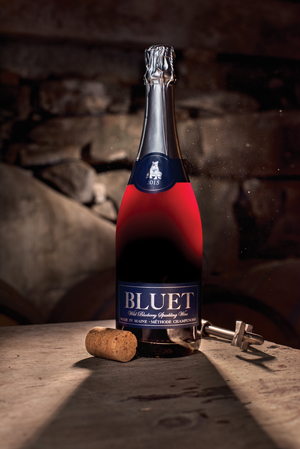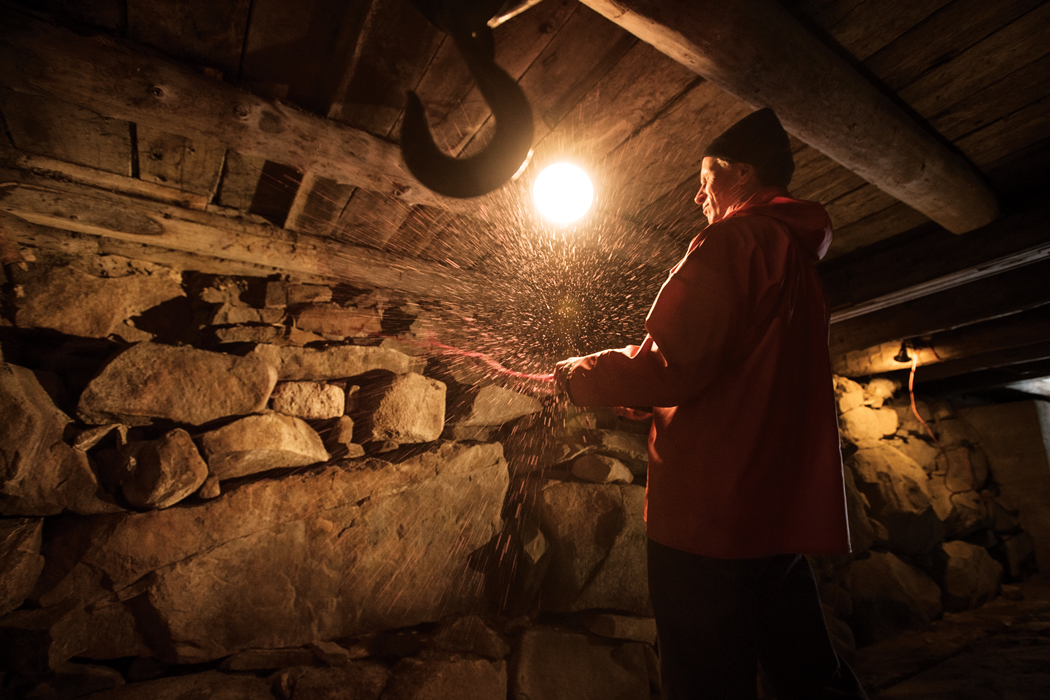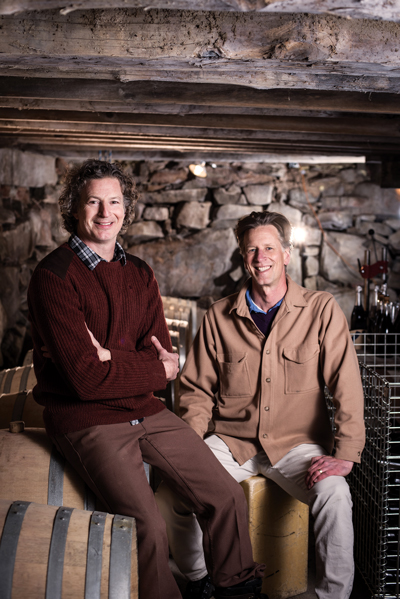And into the black? A pair of winemaking buddies is betting on Maine blueberry bubbly.
By Tina Fischer
Photographed by Brian Fitzgerald
 [cs_drop_cap letter=”P” color=”#99cc00″ size=”5em” ]ffffft! A deep-purple cloud spritzes from the bottle in Michael Terrien’s hands, and the fragrance transports us to a Maine blueberry field at the height of summer. In reality, we’re standing in the fieldstone cellar of a circa-1820 barn in Jefferson, where the vintners of Bluet are hand-disgorging a few bottles of their wild-blueberry sparkling wine. Terrien offers a sip: the wine is crisp and dry, its berry taste lighter than its dark color suggests. Then he sets about disgorging another bottle, popping a temporary “crown” cap to expel spent yeast before quickly corking it, preserving the wine’s essential effervescence. Pffffft!
[cs_drop_cap letter=”P” color=”#99cc00″ size=”5em” ]ffffft! A deep-purple cloud spritzes from the bottle in Michael Terrien’s hands, and the fragrance transports us to a Maine blueberry field at the height of summer. In reality, we’re standing in the fieldstone cellar of a circa-1820 barn in Jefferson, where the vintners of Bluet are hand-disgorging a few bottles of their wild-blueberry sparkling wine. Terrien offers a sip: the wine is crisp and dry, its berry taste lighter than its dark color suggests. Then he sets about disgorging another bottle, popping a temporary “crown” cap to expel spent yeast before quickly corking it, preserving the wine’s essential effervescence. Pffffft!
“This is the old-fashioned way to do it,” Terrien beams, his face freckled with purple spray. Coaxing champagne-style wine from wild Maine blueberries is both messier and more labor intensive than making “still” wines (that is, without bubbles). But for Terrien and business partner Eric Martin, that challenge has become a calling.
“This is Maine — there has to be a good alcoholic beverage made from blueberries,” Terrien recalls thinking five years ago, when he and Martin — who grew up in Cape Elizabeth and South Portland, respectively — first started experimenting with what would become Bluet. Terrien’s been in the wine biz since 1995 and lived in Napa about as long. Martin, who’s also dabbled in the wine world, is now a novelist living in North Carolina. One not-so-ulterior motive behind Bluet? The boyhood pals wanted to pair up on a project that would necessitate frequent visits back home.

that gives Bluet, like a French champagne, its authentically derived fizz.
This July, Martin and Terrien release their third vintage. They’re still tweaking their processes, returning to Maine throughout the year to orchestrate various steps with help from family and friends. Low-bush blueberries from Appleton’s Ridgeberry Farm are harvested and crushed in late summer. Martin and Terrien lay the wine to age in select oak barrels in the cellar of a barn on Damariscotta Lake (most of their barrels are imported from France, though they’re experimenting with a barrel made in Maine from Maine-grown white oak). Then, in late winter, the partners return to bottle their wine with small doses of yeast and sugar, prompting carbonation through fermentation, a process known as le méthode champenoise. In spring comes the hard work of disgorging, corking, and muzzling, all of it done by hand.
“Most sparkling wines are an industrial product,” says Terrien. “Bubbles are forced into the wine as CO2 — they’re not developed like they are with the Champagne method we’re using. These are handmade wines with profound Maine integrity.”
Even the labels are manually applied. The wine takes its name from Thoreau, who called low-bush berries “bluets” and praised their “innocent, ambrosial taste, as if made of the ether itself.” An image of a bear on each bottle’s shoulder is an homage to Robert McCloskey’s Blueberries for Sal, a favorite children’s book in both Martin and Terrien’s families.

Bottles of Bluet, which retail for $22, are only available in Maine, and the company’s first two vintages sold out within months. “It’s got kind of a cult following,” says Tabitha Perry, of Crush Distributors, the only outfit to distribute Bluet. “People in Maine truly love this wine. It’s bone dry, extremely refreshing, and has an addictive quality.” She expects this summer’s 4,000-bottle release won’t linger long on shelves.
Martin and Terrien hope Bluet can transcend cult status, however. They’ve poured some $100,000 into their project so far, an investment not yet recouped. But broader distribution will require increased production and a larger facility, which require more capital. The partners are looking into grants in the hopes of churning out 24,000 bottles a year by 2020. [Since we published this story in print, Bluet won a $100,000 grant on the local entrepreneurial reality show Greenlight Maine.] That increased volume would, in turn, help establish a new market for Maine’s blueberry farmers, who’ve seen prices dip in recent years. “For long-term price stability, we need to add value to the crop,” Terrien says. “Bluet might be the highest-added-value product for Maine wild blueberries — we’re using 3 pounds per bottle.”
For now, Martin and Terrien appreciate being in a “category of one,” the world’s only vintners making authentic champagne-style wine from wild blueberries. And while its deep Crayola hue might raise the eyebrows of die-hard fruit-wine skeptics, the Bluet team envisions a day when blueberry bubbly is as integral as lobster to the quintessential Maine summer feast. Indeed, why not? At between 7 and 8 percent ABV — lower than all but the lightest Rieslings and Moscatos, but quite dry rather than sweet — Bluet makes a fine picnic wine. And the terroir, needless to say, is all Maine.
“Blueberry wine has an intense minerality from the granite soils — it’s an honest interpretation of what this place tastes like,” Terrien says. “This is really an intellectual pursuit about the flavor of a place. If we can make a product that elevates the blueberry, that’d be terrific for everyone.”



